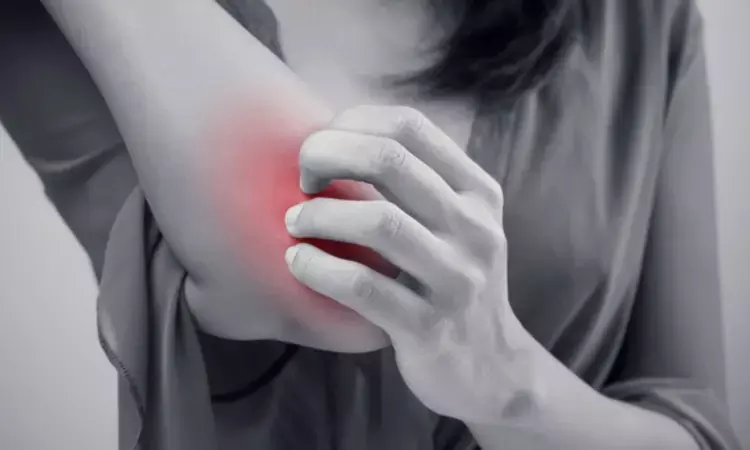- Home
- Medical news & Guidelines
- Anesthesiology
- Cardiology and CTVS
- Critical Care
- Dentistry
- Dermatology
- Diabetes and Endocrinology
- ENT
- Gastroenterology
- Medicine
- Nephrology
- Neurology
- Obstretics-Gynaecology
- Oncology
- Ophthalmology
- Orthopaedics
- Pediatrics-Neonatology
- Psychiatry
- Pulmonology
- Radiology
- Surgery
- Urology
- Laboratory Medicine
- Diet
- Nursing
- Paramedical
- Physiotherapy
- Health news
- Fact Check
- Bone Health Fact Check
- Brain Health Fact Check
- Cancer Related Fact Check
- Child Care Fact Check
- Dental and oral health fact check
- Diabetes and metabolic health fact check
- Diet and Nutrition Fact Check
- Eye and ENT Care Fact Check
- Fitness fact check
- Gut health fact check
- Heart health fact check
- Kidney health fact check
- Medical education fact check
- Men's health fact check
- Respiratory fact check
- Skin and hair care fact check
- Vaccine and Immunization fact check
- Women's health fact check
- AYUSH
- State News
- Andaman and Nicobar Islands
- Andhra Pradesh
- Arunachal Pradesh
- Assam
- Bihar
- Chandigarh
- Chattisgarh
- Dadra and Nagar Haveli
- Daman and Diu
- Delhi
- Goa
- Gujarat
- Haryana
- Himachal Pradesh
- Jammu & Kashmir
- Jharkhand
- Karnataka
- Kerala
- Ladakh
- Lakshadweep
- Madhya Pradesh
- Maharashtra
- Manipur
- Meghalaya
- Mizoram
- Nagaland
- Odisha
- Puducherry
- Punjab
- Rajasthan
- Sikkim
- Tamil Nadu
- Telangana
- Tripura
- Uttar Pradesh
- Uttrakhand
- West Bengal
- Medical Education
- Industry
Worst Itch Numeric Rating Scale may Revolutionize Prurigo Nodularis Treatment Evaluation: JAMA

USA: Prurigo Nodularis (PN), a debilitating skin condition characterized by intensely itchy nodules, poses a significant challenge to patients and healthcare providers. While treatments have been explored, measuring the severity of itch, a hallmark symptom, has remained subjective. However, a recent secondary analysis of two randomized clinical trials has shed light on a potential breakthrough in assessing itch severity: the Worst Itch Numeric Rating Scale (WI-NRS).
The secondary analysis of pooled data from the PRIME and PRIME2 clinical trials revealed that the Worst Itch Numeric Rating Scale may be a valid instrument for pruritus assessment in future clinical trials of prurigo nodularis.
"WI-NRS was a fit-for-purpose and valid instrument to support the efficacy endpoints of clinical trials in prurigo nodularis patients," the researchers reported. "WI-NRS demonstrated good evidence of reliability, validity, and sensitivity to change. The clinically meaningful within-patient improvement threshold was 4 points." The findings were published online in JAMA Dermatology on June 12, 2024.
The Worst Itch Numeric Rating Scale, a simple yet powerful tool, allows patients to rate the intensity of their worst itch on a numerical scale. By providing a standardized measure of itch severity, this scale enables clinicians to more accurately assess the effectiveness of treatments and tailor interventions to individual patient needs.
Shawn G. Kwatra, Johns Hopkins Medical Institutions, Baltimore, Maryland, and colleagues aimed to validate the psychometric properties and determine the clinically meaningful improvement threshold for WI-NRS in patients with moderate to severe PN.
In the analysis, the researchers assessed the content validity of WI-NRS through in-depth patient interviews. Psychometric assessments used pooled data from masked, intention-to-treat (ITT) PN patients from randomized, double-masked, and placebo-controlled studies.
Psychometric assessments included known-groups validity, construct validity, test-retest reliability, and sensitivity to change in adult moderate-to-severe PN patients. Thresholds for meaningful within-patient WI-NRS score improvement were determined using anchor and distribution-based approaches.
The patients were given dupilumab (300 mg) or placebo subcutaneously every two weeks for 24 weeks. The study's main outcome was WI-NRS score at specified time points for 24 weeks after randomization.
The following were the key findings of the study:
- Twenty patients were included across the 2 studies (mean age, 49.3 years; 55% females); 311 patients were included in the pooled intention-to-treat analysis (mean age, 49.5 years; 65.3% females).
- The WI-NRS questions (20 of 20 patients), response scale (20 of 20 patients), and recall period (19 of 20 patients) were easy to understand and relevant for patients with PN.
- Adequate test-retest reliability was observed between screening and baseline (intraclass correlation coefficient = 0.72, using Patient Global Impression of Severity [PGIS] to define stable patients).
- Convergent and discriminant validity was supported by moderate to strong correlations with other conceptually related measures and weaker correlations with less related measures, respectively.
- WI-NRS was sensitive to change, as shown by differences in change from baseline among groups (per PGIS change and PGI of Change [PGIC]).
- Using an anchor-based approach with PGIS and PGIC, the clinically meaningful improvement threshold was 4 points, also supported by distribution-based methods.
"The study found that WI-NRS may be a fit-for-purpose instrument to support efficacy endpoints measuring itching intensity in adults with Prurigo Nodularis," the researchers wrote.
Reference:
Kwatra SG, Yosipovitch G, Kim B, et al. Worst Itch Numeric Rating Scale for Prurigo Nodularis: A Secondary Analysis of 2 Randomized Clinical Trials. JAMA Dermatol. Published online June 12, 2024. doi:10.1001/jamadermatol.2024.1634
Dr Kamal Kant Kohli-MBBS, DTCD- a chest specialist with more than 30 years of practice and a flair for writing clinical articles, Dr Kamal Kant Kohli joined Medical Dialogues as a Chief Editor of Medical News. Besides writing articles, as an editor, he proofreads and verifies all the medical content published on Medical Dialogues including those coming from journals, studies,medical conferences,guidelines etc. Email: drkohli@medicaldialogues.in. Contact no. 011-43720751


